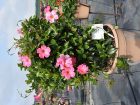
Features
Crops
Flowers
Bring on the Heat
This was a summer of sun, drought and sizzling temperatures. So which varieties held up under those demanding conditions with good performance throughout the season in trials located in the heart of southwestern Ontario?
October 25, 2016 By Melhem Sawaya
November 2016 – This year featured a much warmer than usual summer, by far the hottest summer I have seen since we first hosted the Sawaya Garden Trials 16 years ago.
The continuously hot days and nights put the plants through new stress or benefit tests depending on the varieties. Some varieties, such as the lantanas, angelonias, portulacas and scaevola, did exceptionally well. However, others did not do so well. The annual hibiscus dropped their buds before they could open, while the dahlias did not have a chance and collapsed before the end of July.
As well, some misconceptions about some genera were cleared up.
For example, nemesia, diascia and osteospermum flowered throughout the season and some varieties were better than other years. Even though they are considered cool weather crops, they can stand extreme heat if they are watered regularly.
Another surprise was the Cool Wave pansy series that flowered the whole summer. So for fall pansies in your combinations, Cool Waves are much better than the upright cultivars.
The hot weather and the lack of rain suited petunias very well. All varieties performed exceptionally well, with no sign of botrytis and loads of flowers. The geraniums also did well and for the same reason – no rain, no botrytis.
To benefit from trials, it’s important to apply what we’ve learned next season. It is time to put the horticulture industry on a progressive track that puts consumer success as its main priority.
Usually when we go to trial gardens we look for varieties that are good performers, which is great. But what is more effective is to look for the non-performers and eliminate them from your program to send a message to suppliers.
The main purpose of Sawaya Garden Trials is to see the varieties that perform best in our climate. In my assessment, calibrachoa production has increased over a thousand-fold, and not only in Ontario, but throughout other regions of Canada as well. This dramatic increase is due to its excellent garden performance, and the excellent show it puts on from early spring to late fall as long as we are able to fertilize it with every watering. The next genus I’ve seen to be increasing in popularity faster than the supply is the begonia boliviensis.
So why are gardeners not getting the full potential beauty out of their plants?
The answer is simple – we are not communicating effectively with the ultimate consumer.
Here are some of the same steps I have mentioned the last two years to increase our sales. Normally it takes five years to adopt a change, so here I am mentioning it again.
Only grow varieties that are proven to perform well in the garden.
Sell the plants in larger containers than you are used to. The rule-of-thumb is that if you have to apply growth regulators more than once to make the plant fit, then the container is most likely too small for the plant.
Always plant in a good potting media, and with no weird additives. Trying to prolong plant watering by 12 to 24 hours creates a false expectation for consumers.
Top-dressing the containers with slow-release fertilizer could be a setback for varieties that cannot take a heavy dose of fertilizer all at once and that will happen when we get high temperatures. All of the slow-release fertilizers I’m aware of are released based on temperature and especially if the plants are not getting water when they should.
Provide free liquid fertilizer as a bonus. Mix it in a 200-litre barrel at about a thousand times concentration so the consumer can dilute it to end up with a fertilizer of about 150 ppm.
If we don’t do anything else, we must sell simplified drip kits so the home-owner can water his plants effectively and regularly.
Get involved by promoting plants and their benefits.
Here are some highlights from our trials this summer. These varieties are not in any order of importance.
Remember if you have never grown any of these varieties but would like to, just grow a small percentage of your production to evaluate their success during production and also evaluate consumer appeal. With this information, you can then decide to increase production or drop them. If you decide to increase production of a new variety after trialling it for a season, make sure you take a good look at which variety you can drop.
With the popularity of calibrachoa, you can now choose from among a variety of colours, sizes and habits. Breeders are doing a good job of classifying the
series according to its habit, which helps in matching container size to the variety. The many different types of flowers add to its popularity, including star-shaped bicolour flowers, varieties with a different colour around the rim of the flowers, varieties that change colour as they age, and those with double flowers.
Petunias were stunning this year due to the hot, dry weather. However, there are always some cultivars that outshine the others and here are a few.
Petunia hybrida ‘Picnic White Imp.’ (1) is pure white with nicely trailing medium-size flowers that recovered quickly whenever it rained. It was loaded with flowers the entire season and is great alone or in combinations.
Petunia Supertunia ‘Sangria Charm’ (2) is one in this nine-colour series that features loads of small flowers. Sangria is very vigorous, but at the same time flowers very early. This is the sign of a petunia with excellent performance. It is great in 4” pots or 14” containers, and in landscapes and combinations.
Petunia Tidal Wave ‘Silver’ and ‘Red Velour’ (3) are varieties in an old series that has garden performance that exceeds most petunias. Tidal Wave is vigorous with never-stop flowering that is not set back by rain and experiences no botrytis. Plant early in April to get a large container by – or before – the long May weekend. Tidal Wave is also great in landscapes.
SuperCal ‘Salmon Glow’ (4) is one colour of many in the Petchoa series. It is an excellent garden performer that recovers from heavy rain in one hour or less and the flowers last a long time. No deadheading is needed because there is more than a flush of flowers formed before the second or third generations are spent. Petchoa is great in large baskets and in combination with other Petchoa colours or other cultivars or genera.
Petunia Supertunia Vista ‘Bubblegum’ and ‘Fuchsia’ (5) have been steady stars in our trials for the last five years. Vistas are excellent performers. They are vigorous, and require no deadheading. There is no downtime because of rain and they put on a show that is second to none.
Calibrachoa Chameleons (6) is an interesting new series. The name is very descriptive because the flowers change colour with age! Every Chameleon variety is a combination of colours that makes them a very unique series. They are excellent in hanging baskets, large containers combinations and landscapes.
‘MiniFamous Double Lemon Improved’ (7) is one of a double series that adds more show and value to the calibrachoa’s already excellent garden performance. I have seen some combinations with this variety that look exceptionally good. The different colours of the double MiniFamous series can make excellent combinations.
‘Smart Look Red’ (8) is an outstanding bright red celosia that performed exceptionally well in our garden trials. The Smart Look is very appealing, given the surge in popularity of vegetative celosias that are about 10 times the cost of seed varieties. It even performs better than many of the vegetative cuttings. It is great for landscapes and combinations.
Dracula (9) is a unique Crestata celosia that performed well in our trials in full sun. No deadheading is required and it looked better with age. Abi (our trials technician) gave it the nickname Dracula Brain. She said it has a blood colour and looks like a brain. You cannot argue with her logic!
Celosia Spicata Kelos ‘Atomic Neon Pink’ (10) put on a show the whole summer in full sun and obviously thrives in hot weather. Try it in 4″ pots, gallons or larger containers. It is a very different and solid performer.
‘Diamond Coral’ (11) is a perennial dianthus that took the heat very well and got better as September came along. Diamond would work well for early spring sales and through the whole spring season. It has great performance in cool weather and in the heat.
Interspecific Jolt ‘Cherry’ and ‘Pink’ (12) puts dianthus in a higher level than what dianthus is known for. This is a vigorous variety with great colour and a large head. It takes the heat very well. It needs growth regulators when produced in the winter months but make sure to use low rates because it is very responsive. Jolt is great in large containers and landscape gardens.
Sun Parasol ‘Pretty Pink’ (13) is a trailing mandevilla, and like many other mandevillas it has exceptional garden performance and truly loves the heat. Mandevillas are well known by consumers now who buy them whether they have colour or not because they know that they will have great flowers and will perform quite well.
Mandevilla Siesta ‘Frisia Flora’ (14) is an exceptionally vigorous mandevilla with semi-double and larger flowers. It is great in large containers or towers.
‘Sweet Memories’ (15) is one of many colours in this series. The main advantage of Garvinea gerbera is that it is very mildew resistant. As a matter of fact I cannot see any powdery mildew even as I am writing this article on the 20th of September and the plants are still growing new flowers. We know Garvineas are successful garden plants in pots or in beds as we trialled them in both.
Geranium Brocade ‘Fire Night’ (16) has a very distinctive dark zoning contrast on the green leaf edge with lots of single flowers. It is a good performer in large containers, landscapes or combinations.
Geranium Bullseye ‘Light Pink’ (17) has better garden performance than any of the other geranium I’ve seen recently, including the vegetative varieties. It has the same zoning as the Brocades but more flowers and it can take the rain better. Bullseye geraniums are excellent in large containers and are knockouts in the landscape.
Impatiens New Guinea SunStanding ‘Coral Aurora’ (18) looks and performs a lot like Sunpatiens. With downy mildew continuing to be concern on walleriana impatiens, these hybrids are the standard for impatiens.
Sunpatiens Compact ‘Deep Rose Green Leaf’ (19) is the mother of the hybrid impatiens and has excellent performance in the shade and even better performance in the sun. This year the Sunpatiens took the heat very well throughout the summer. Sunpatiens is great in large containers, landscapes or combinations.
‘Beauvillia Salmon’ (20) is a trailing begonia that looks great in hanging baskets. It has lots of flowers and branches very well, which is characteristic of the Beauvillia series. Make sure to try some because it is getting a positive response from consumers and is fairly easy to grow. Remember, it is a tuberous begonia so long days are needed until March 21 at the earliest.
‘Unbelievable Miss Montreal’ (21) has large flowers, dense foliage with a mounding habit, and exceptional garden performance in the sun or shade. Boliviensis begonia are newcomers into the bedding plant market. Their versatility and outstanding show will dominate many other genera.
Begonia ‘BIG Rose Green Leaf’ (22) is one colour in this series. BIG has outstanding garden performance and looks great from three feet or 30 feet away. The flowers are always on the top. It is continuously producing new flowers. BIG begonias are great in large containers, perfect centres for combinations, and offer the ultimate show in landscapes.
‘Nirvana Cascade Pink Splash’ (23), like all other vincas, thrived during this summer’s series of hot, dry and sunny days. ‘Pink Splash’ is a cascading variety that looked great the whole summer. It required no deadheading and the flowers lasted a long time. Its bicolour flowers attracted every visitor. Vinca in hanging baskets does not have to be sold in June only, but can be part of your mix in May.
‘Valiant Punch’ (24) is an upright plant that branches freely, which gives it the ability to grow more flowers. It is excellent in landscapes, and especially in sunny areas. Vinca is not only for southern climates, as our summers are way more hot and sunny enough for them!
Zinnia Elegans ‘Magellan Pink’ (25) is one colour in this series that had great show the whole summer. I took a picture every time I looked at the Magellan series because they jump at you and as they say, “take my picture, please!” Magellans are great in large containers and landscapes.
Verbena vegetative ‘Lascar Mango Orange’ (26) is very popular in combinations because of its colour and habit. ‘Mango Orange’ is powdery mildew resistant and has great long lasting flower power.
‘Endurascape Pink Bicolor’ (27) has a stunning flower colour that stands out either alone or in combinations. The vegetative Endurascape series is not like other verbenas because it is the variety that holds its flowers longer than most other verbenas. This is a breakthrough in verbena breeding. It makes Endurascape a viable plant in combinations without having the agony of deadheading it (even in the greenhouse!) like many of the other verbenas.
Confetti Garden Combo ‘Starry Night’ (28) was exceptional in our trials. We had over 200 combination planters this summer, but ‘Starry Night’ stood out for maintaining its rounded look the whole summer. All of its components performed well all season, unlike some other combinations in which one cultivar begins to dominate beginning in mid-June.
Dragonwing and Mother Nature’s poplar combination (29) is my favourite combo. We planted the Dragonwing begonia in our tree structure and within weeks the poplar plant (at back) showed up to give height and an unplanned great look to this poplar combination, courtesy of Mother Nature!
The website version of this feature will have a few more varieties that caught my eye. Check it out at greenhousecanada.com
This year’s trial pictures have been posted to my website at sawayagardentrials.ca. Questions or comments are always welcome at mel@focusgreenhousemanagement.com.
Melhem Sawaya of Focus Greenhouse Management is a consultant and research coordinator to the horticultural industry – mel@focusgreenhousemanagement.com.
Print this page



























